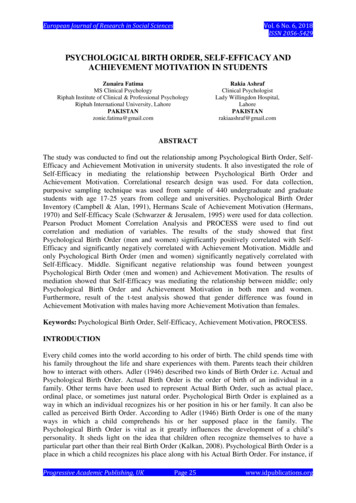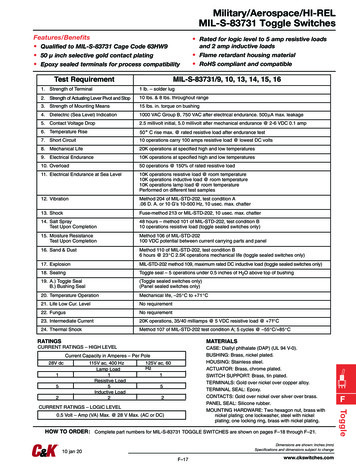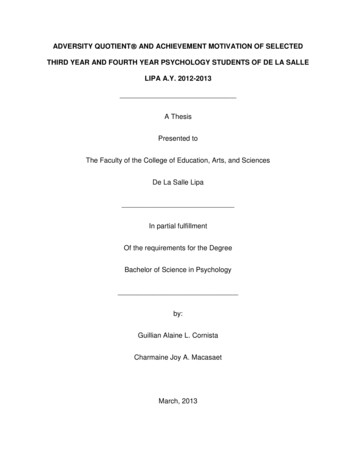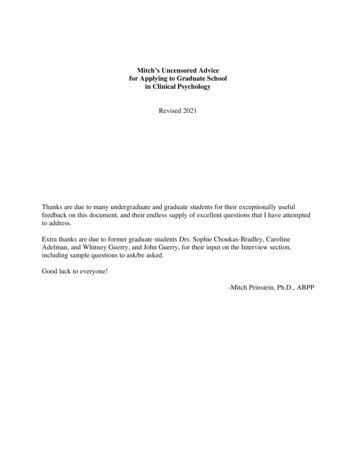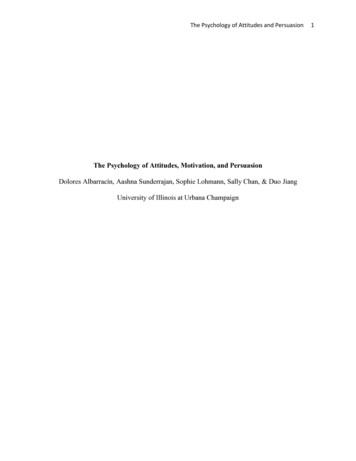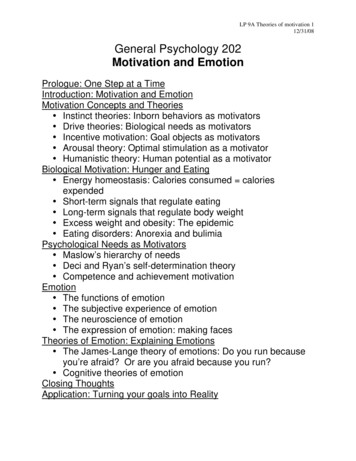
Transcription
LP 9A Theories of motivation 112/31/08General Psychology 202Motivation and EmotionPrologue: One Step at a TimeIntroduction: Motivation and EmotionMotivation Concepts and Theories Instinct theories: Inborn behaviors as motivators Drive theories: Biological needs as motivators Incentive motivation: Goal objects as motivators Arousal theory: Optimal stimulation as a motivator Humanistic theory: Human potential as a motivatorBiological Motivation: Hunger and Eating Energy homeostasis: Calories consumed caloriesexpended Short-term signals that regulate eating Long-term signals that regulate body weight Excess weight and obesity: The epidemic Eating disorders: Anorexia and bulimiaPsychological Needs as Motivators Maslow’s hierarchy of needs Deci and Ryan’s self-determination theory Competence and achievement motivationEmotion The functions of emotion The subjective experience of emotion The neuroscience of emotion The expression of emotion: making facesTheories of Emotion: Explaining Emotions The James-Lange theory of emotions: Do you run becauseyou’re afraid? Or are you afraid because you run? Cognitive theories of emotionClosing ThoughtsApplication: Turning your goals into Reality
LP 9A Theories of motivation 212/31/08MotivationMotivation:The biological, emotional, cognitive or socialforces that activate and direct behavior.There are three basic characteristicsassociated with motivation Activation (initiation of behavior) Persistence (continual efforts ordetermination) Intensity (strength of response)Theories of Motivation Instinct Theories Drive Theories Incentive Theories Arousal Theories Humanistic Theories
LP 9A Theories of motivation 312/31/08Instinct TheoriesJust as animals display instinctive behavioralpatterns, such as migration or mating behaviors, humanbehavior is thought be motivated by innate instincts orgenetic programming.Instinct theories say that people are motivated toengage in certain behaviors because of evolutionaryprogramming.Examples of InstinctsProposed by Instinct Theorists Instinct theorydescribes and labelsbehavior and relies oncircular reasoning. While instinct theoriesseem logical, theselabels anddescriptions do notexplain behavior.In addition, we don’thave enough genesto account for everybehavior andmotivation. Peopletry to use instincts to“explain” onesbehavior, but it rarelydoes.
LP 9A Theories of motivation 412/31/08Drive TheoriesBehavior is motivated by the desire to reduce internaltension caused by unmet biological needs, such as hungerand thirst (p. 330).These unmet biological needs “drive” us to behave incertain ways to ensure survival. Drives such as hungerand thirst arise from tissue deficits--when we are hungry,we are driven to eat. When we are thirsty, we are drivento drink.When a particular behavior reduces a drive, thebehavior becomes reinforced when the same need statearises again.
LP 9A Theories of motivation 512/31/08Our bodies biological systems are delicately balancedto ensure survival (page 330). Homeostasis is a state ofinternal physiological equilibrium that the body strives tomaintain.For example, when you are hot, your body automatically tries tocool itself by perspiring. when you are cold, your body generates warmth byshivering.Physiological disruptions in homeostasis producedrives—states of internal tension that motivate anorganism to reduce this tension.Where else have we heard the concept of homeostasisbefore?
LP 9A Theories of motivation 612/31/08Incentive TheoriesBehavior is motivated by the “pull” of external goalsand rewards such as rewards, money or recognition (page331).This approach is based heavily on operant learningtheory (behavior is based on the expectation ofconsequences such as reinforcements or punishments,Chapter 5), and hence testable.Reinforcements behaviorPunishmentsbehavior If we think we will be reinforced for the behavior, weare motivated to engage in that behavior. If we think we will be punished for the behavior, weare motivated to avoid that behavior.
LP 9A Theories of motivation 712/31/08Arousal TheoriesArousal theories are based on the observation that peoplefind both very high levels of arousal and very low levels ofarousal quite unpleasant. When arousal is too low, we become motivated toincrease arousal by seeking stimulatingexperiences When arousal is too high, we become motivated toreduce arousal by seeking a less stimulatingenvironment.People are motivated to maintain an optimal level ofarousal—one which is neither too high or too low.
LP 9A Theories of motivation 812/31/08
LP 9A Theories of motivation 912/31/08Humanistic TheoriesAbraham Maslow, a humanistic theorist, proposed abroad motivational model. He proposed that psychology’sother perspectives ignored a key human motive—thedesire to strive for personal growth.Maslow’s concept of self-actualization is hard todefine, test and give too little weight to incentives.
LP 9A Theories of motivation 1012/31/08Table 8.2: Maslow’s Characteristics of Self-Actualized PeopleRealism andSelf-actualized people have accurate perceptions ofacceptancethemselves, others, and external reality. They easilyaccept themselves and others as they are.SpontaneitySelf-actualized people are spontaneous, natural andopen in their behavior and thoughts. However, theycan easily conform to conventional rules andexpectations when situations demand such behavior.Problem centeredSelf-actualized people focus on problems outsidethemselves. They often dedicate themselves to alarger purpose in life, which is based on ethics orsense of personal responsibility.AutonomyAlthough they accept and enjoy other people, selfactualized individuals have a strong need for privacyand independence. They focus on their ownpotential and development rather than on theopinions of others.ContinuedSelf-actualized people continue to appreciate thefreshness ofsimple pleasures of appreciation of life with awe andappreciationwonder.Peak experiencesSelf-actualized people common have peakexperiences, or moments of intense ecstasy, wonderand awe during which their sense of self is lost ortranscended. The self-actualized person may feeltransformed and strengthened by these peakexperiences.What do all of these theories of motivation tell us aboutwhat motivates behavior?
LP 9A Theories of motivation 1112/31/08Hunger and Weight RegulationMany Americans are obsessed with achieving, or atleast getting closer to, the socially desirable goal ofthinness. Approximately one-third of all American womenand one-fourth of all American males are trying to loseweight, and the weight -loss industry is a 33 billion a yearenterprise. Based on what you have read in your text, whatadvice would you give to a friend who is trying to loseweight? A recent finding indicates that 64% of American adults(115 million adults) are overweight or obese. This is alarge increase in the last 50 years. Based on whatyou have learned on intelligence, explain why thisgain in weight is not a genetic change in the Americanpopulation, but most likely an environmental change? What factors lead a person to become overweight andobese?*(from Study Guide for Psychology by Cornelius Rea to AccompanyPsychology by Hockenbury and Hockenbury, page 130):
LP 9A Theories of motivation 1212/31/08Hunger and Weight RegulationWith an obsession with losing weight, consumers areeasier to become persuaded by easy remedies such as: Weight-loss products such as “Slimming Insoles” thatsupposedly help you lose weight with every step The Svelt-Patch that “melts away fat as you sleep” Absorb-it-ALL Plus supplements promise you will losethree inches from your thighs. A book, Dr. Hirsch’s Guide to Scentsational WeightLoss, claims that inhaling certain odors will reducehunger; a one-month supply of aroma “pens”(banana, green apple, and peppermint) sells for 45. Subliminal tapes to decrease the motivation to eat.What motivates us to eat?
LP 9A Theories of motivation 1312/31/08Hunger and Weight RegulationFood intake: Does energy in energy out?There are many biological, psychological andenvironmental factors that regulate our food intake.
LP 9A Theories of motivation 1412/31/08Short-term Signals that Regulate EatingPhysiological Changes Blood Glucose Ghrelin (GRELL-in)
LP 9A Theories of motivation 1512/31/08Set-Point Theory / Settling Point TheoryMany researchers believe that there is a set point—abiologically determined “standard” around which bodyweight (fat mass) is regulated.For example, As you eat fewer calories, your BMR decreases As you eat more calories, your BMR increases
LP 9A Theories of motivation 1612/31/08
LP 9A Theories of motivation 1712/31/08The physiology of hungerMetabolism: The body’s rate of energy (or caloric)utilization. Age: BMR slows down with increased age, especiallyduring the first two decades of life Gender: Males tend to have higher metabolic ratesthan women Body size: Heavy people tend to have a highermetabolic rate than slender people* Genetics: Evidence strongly suggests that the BMRis influenced by heredity Diet: Restricted food intake lowers BMR; excess foodintake increases BMR
LP 9A Theories of motivation 1812/31/08Signals that Start and Terminate a MealNot only do contractions in the stomach lead to feelings ofhunger, but other factors the feeling of hunger. Glucose Cholecystokinin (CCK)GlucoseA simple sugar that is the body’s majorsource of immediate usable fuel. Whenblood glucose levels slightly decrease,stored nutrients are used to restore bloodglucose levels and may stimulate the desireto eat.CCKA peptide (a type of hormone) that helpsproduce feelings of satiation. As food arrivesin the small intestine, CCK is released intothe bloodstream that travel to the brain andstimulate the brain to decrease food intake.
LP 9A Theories of motivation 1912/31/08Signals that Regulate General Appetite and WeightLeptin:A hormone secreted by fat cells and released into thebloodstream.As fat stores increase, leptin increases and eatingdecreases. When leptin reaches the brain, itdecreases appetite and increases energy use.Hypothalamus:Ventromedial hypothalamus (“hunger off”)— Whenthe ventromedial hypothalamus (VMH) is damaged,rats will eat until they become obese-—but only if thefood is appetizing.
LP 9A Theories of motivation 2012/31/08Psychological Aspects of HungerAttitudes, habits, and psychological needs regulate foodintake. “Don’t leave food on your plate” attitude increases thelikelihood that we will finish what is on our platedespite feeling full “autopilot snacking” while watching TV may lead us toeat even when we don’t feel hungry, thus eating more Social expectations—especially for women pressurewomen to conform to an idealized norm.
LP 9A Theories of motivation 2112/31/08Environmental and Cultural FactorsFood availability Too little Too muchFood taste and food variety Good tasting food increases consumption Food variety increases consumption (eg. buffets)
LP 9A Theories of motivation 2212/31/08Factors the Influence Eating BehaviorBiological Basil Metabolic Rate (BMR) CCK—a hormone that helps produce feelings ofsatiation (released by small intestines when foodarrives) Glucose levels (low levels associated with hunger) Leptin (secreted by fat cells) Abnormal hypothalamus activityPsychological Attitudes Habits (automatic eating when watching TV) Social expectations for womenEnvironmental factors Food availability Too little Too much Food taste and food variety Good tasting food increases consumption Food variety increases consumption (eg. buffets)
What do all of these theories of motivation tell us about what motivates behavior? LP 9A Theories of motivation 11 12/31/08 Hunger and Weight Regulation Many Americans are obsessed with achieving, or at least getting closer to, the socially desirable goal o

